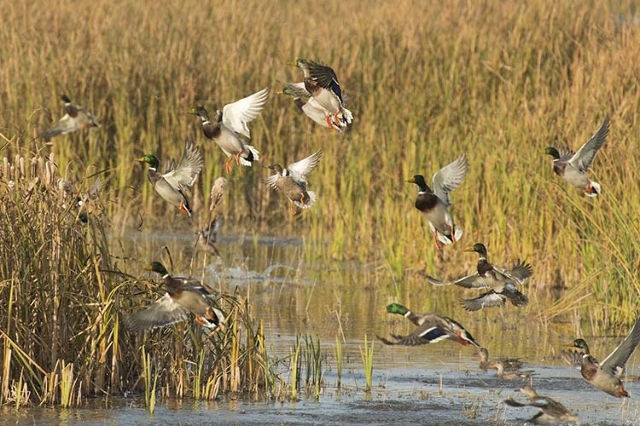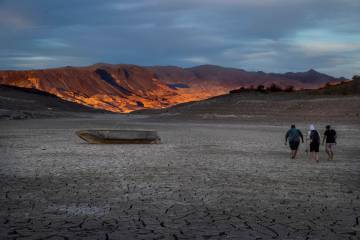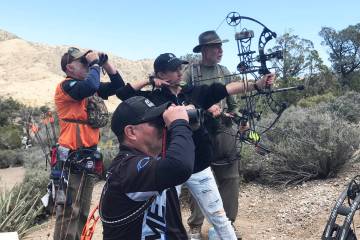First duck hunt: Family fun, but no fowl felled
When we left Dale Rust's cabin at Sunnyside, the hour was so early that it was still nighttime. Well, at least it seemed to be. The temperature was cold enough, as they say, that one could hang beef. If one could find a tree somewhere to hang it in.
Valleys in central Nevada aren't known for their large stands of trees, or even their small ones, for that matter. One generally has to make his way to the foothills if he wants to find one.
From the cabin, we followed Rust down a dirt road covered in dust so light that it seemed to hang in the air like thick fog over an oceanfront marina. Keeping up with Rust was a challenge, but despite the dust, Jay somehow managed to stay close enough that we didn't get turned around in the dark. Luckily, our trip was a short one.
We knew we had arrived when the Bronco's headlights shined on the aluminum boats staged along the shoreline near the upper launch ramp at Adams-McGill Reservoir. As we jumped out of the truck, Rust provided us with some brief words of encouragement. At the time, it seemed like he thought we should be moving faster. I still think so.
Looking around, I couldn't help but notice that most of the other hunters at work in the headlights were dressed in camouflage. Then I looked at our little group, comprised of my wife's father, her brothers Jay and Daniel, and me. Our coats were in subtle colors that blend into nature quite easily, such as orange and red.
"Gee, do you think anybody will notice we are new to duck hunting?" I thought to myself.
Just then Rust walked up, and while pointing toward some landmark located somewhere amongst the tules, he hurriedly explained where he thought we should be when the sun came up and the ducks started flying. Then he jumped in a boat with his hunting partner and rowed into the darkness.
Doing our best to the follow the others' examples, we loaded our shotguns, blankets, sleeping bags and other important gear we thought essential for a cold duck hunting morning and pushed aware from the shoreline. Then we rowed into the darkness, somewhere in the general direction we thought Rust had pointed. In reality, we had no idea where we were going and kind of fiddled our way along the edge of some tules until it grew light enough to see.
With the sunrise came the sounds of shotguns booming in the distance. We guessed that meant the birds were flying. So we found a place where tule beds created a channel and pulled the boat into the tules on the southeast side. Just far enough that the tules held the boat in place, but not far enough that the tules provided much in the way of concealment.
We hunkered down in the cold and waited for ducks to fly into shooting range. In the distance, we could hear other hunters working their duck calls. We didn't have one of those and wouldn't know how to use it if we did. To keep our minds off the bone chilling cold, we talked about this and that, we laughed, and we waited.
Ducks flew in our direction but always seemed to flare away or climb in altitude just as they neared our location. Our urban camouflage wasn't helping our cause. The ducks easily picked out what we thought to be our hiding place in the tules. Once the birds had us pegged, they simply adjusted their flight patterns and moved out of range.
As the sun finally showed itself, the cold dissipated, and we could begin shedding layers. Every once in a while, a duck or two somehow made the mistake of flying close enough that we dared take a shot. It was then I learned just how fast ducks can fly. We put some shot in the sky but did little more than urge the birds to fly faster and higher.
Looking back, I can't help but laugh. We must have stood out like a bandage on the proverbial sore thumb. And we probably talked and laughed loud enough to frustrate other hunters who were secluded nearby. For that, I must apologize; we just didn't know any better.
The ducks got the better of us that day. We didn't have to clean a single bird, but we added to our knowledge of outdoor things and brought home a cooler full of memories from that first duck hunt. Now those memories and others from our outdoor exploits provide the seasoning for conversations when we gather together as a family or sit around a campfire.
Experiences such as this is what hunting and fishing are all about.
Freelance writer Doug Nielsen is a conservation educator for the Nevada Department of Wildlife. His "In the Outdoors" column, published Thursday in the Las Vegas Review-Journal, is not affiliated with or endorsed by the NDOW. Any opinions he states in his column are his own. He can be reached at intheoutdoorslv@gmail.com.






















